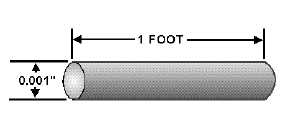1-25
Conductor Sizes—The square mil and the circular mil are the units of measure used to determine
the cross-sectional area of electrical conductors. The square mil, as it relates to a square conductor, is the
cross-sectional area of a square conductor that has a side of 1 mil. The circular mil is the cross-sectional
area of a circular conductor having a diameter of 1 mil. The circular mil area (CMA) of a conductor is
computed by squaring the diameter of the circular conductor is mils. Thus, a wire having a diameter of 4
mils (0.004 inch) has a CMA of 42, or 16 circular mils. If the conductor is stranded, the CMA for a strand
is computed, and the CMA for the conductor is computed by multiplying the CMA of the strand by the
number of strands. The relationship of the square mil to the circular mil is determined by comparing the
square mil area of a circular conductor having a diameter of 1 mil (A = pr2) to the circular mil area of the
same conductor (D2). Therefore, there is 0.7854 square mil to 1 circular mil. There are more circular mils
than square mils in a given area.
Specific Resistance—The specific resistance of a substance is the resistance in ohms offered by a
unit volume (the circular-mil-foot) to the flow of electric current. The three factors that are used to
calculate the specific resistance of a particular conductor are (1) its length, (2) its cross-sectional area, and
(3) the specific resistance of a unit volume of the substance from which the conductor is made. The
specific resistance for various sizes and lengths of standard solid copper wire can be determined by the
use of tables.
Wire Gauge—A wire gauge is used to determine the American Standard Wire Gauge size of
conductors. The measurement of a bare conductor is taken in the slot, not in the circular area at the
bottom of the slot.
Selection of Wire Size—Four factors must be considered in selecting the proper wire size for a
particular electrical circuit. These factors are (1) conductor size, (2) the material it's made of, (3) the
location of the wire in the circuit, and (4) the type of insulation used. Some of the types of insulation used



